Pyre Review: Light My Fyre
From the creators of Bastion and Transistor comes a... visual novel RPG?
This article first appeared on USgamer, a partner publication of VG247. Some content, such as this article, has been migrated to VG247 for posterity after USgamer's closure - but it has not been edited or further vetted by the VG247 team.
Semi-Spoiler Warning: I do talk about the plot at a vague capacity, so if you're one of those players who plans to go in blind, don't read this.
I was so shocked when I suffered my first loss in Pyre. It was a seemingly unloseable trial too: our second Liberation Rite, the game's biggest spiritual matches. I was set to let another ally escape from this wretched banishment upon our expected success.
I had already foresaw how this would go, naively. When we won, our friend would escape far away from the Downside (our purgatory, our hell, whatever this place is where exiles live down below civilization). I hoped that they would find peace up above in the Commonwealth, and find it in their hearts to set action upon our preconceived "Plan." A "Plan" of quiet organized rebellion, that is.
But they didn't. We lost. The opposing adversary instead floated into the glowing beam of light up into the sky. They received freedom. Our friend did not.
This loss is where I learned that there was no game over screen in Pyre. There are no do-overs (unless you save scum, probably, like a cheater). You have to live with your mistakes and bear the consequences—narratively, in the negligible experience points you receive, and in the heavy guilt you feel in your soul.
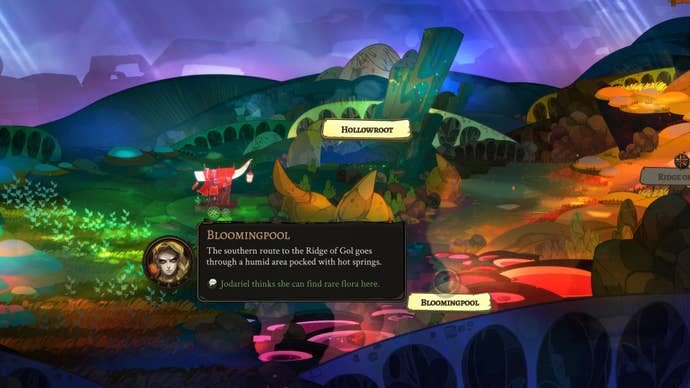
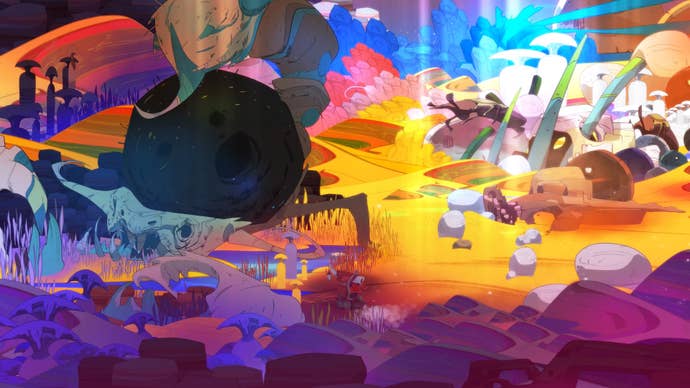
The Downside is the setting for Supergiant Games' latest title Pyre, where exiles of the corrupt-governed land of Commonwealth dwell. The Downside is where people are cast off to; banished; left to fester among other sinners. Most are there because of miscellaneous crimes, from petty to rebellious to hardly anything at all, like being guilty of inquiring too much. The Downside is clearly a place for those who weren't living as "peacefully" in Commonwealth as their government wanted to, so they're sent down below. Cut off from their friends and families, left to claw at Rites as their only hopes for freedom and returning back home.
Pyre is a game unlike the frolics of Supergiant's past (Bastion, Transistor): there's no isometric world, no narrator, no attitude. The only things that really remain of their DNA are its excellent art direction and swoon-worthy melodies. Pyre's a different gamble altogether. It's billed as an RPG, but really it's more of an expansive visual novel, with maybe 30 percent tactical RPG sprinkled in-between. It's in the visual novel where Pyre loses its wagon wheels a little bit, in a world that doesn't do much to make its characters feel worth saving, nor their cause.
The Downside is a beautiful, entrancing place to spend time at least, but it's also a cursed one. Every locale usually has the husk of a greater being within it (a skeleton, the remnants of a giant scorpion). At these sort of landmarks is where the stars are the clearest, and thus where your band of exiles roll up to in their janky wagon to perform a spiritual Rite. Together you gaze up at the stars, light your pyre, and set forth into battle.
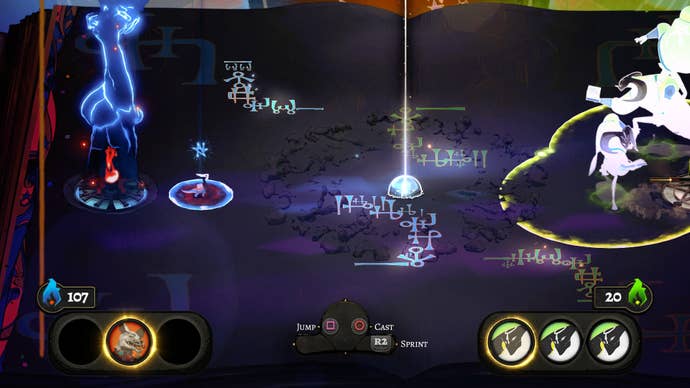
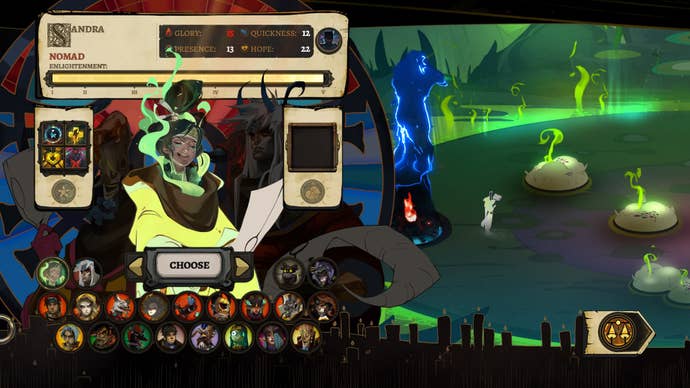
As a visual novel, Pyre has you navigating dialogue options, and on the road, direction choices. The characters that slowly join your quest are all memorable in their own way (even if most come off one-dimensional), and not just in terms of their lavish character designs. There's acquaintances like Rukey, the loud "cur" (a fox… thing) with an energetic personality. Or Ti'zo, a drive-imp that only communicates in sound, with only a handful of others being able to understand the creature's intent (yourself, known as "the Reader," included). The characters aren't just varied in their personality and appearance, but in how they are on the battlefield too.
That is, if you call the Rites battlefields. Rites are by nature non-violent. Every character moves across the rectangular maps differently, each with their own unique abilities. For example, the towering Pamitha can fly high above foes, but also has potential to be knocked down; this is contrary to a character like Rukey, who's quick speed is essential for a quick douse into an adversary's pyre. Dousing pyres is a lot like scoring a goal in any sport. Every character has an aura surrounding them, one that can banish a foe temporarily should they touch it (when a character is holding the orb, Pyre's version of a basketball, it makes them vulnerable). You can equip magical talismans and miscellaneous "masteries," or additional passive abilities, to your characters in the midst of it all. (This is an RPG after all.)
In a lot of ways, Rites play like a sport. They're three-versus-three battles, with each pyre beginning with 100 points. Some characters do more damage than others—usually the smaller and faster they are, the weaker their goals are, and so on. In my matches, I'd usually keep one character on guard as an impromptu goalie, and pass the orb back and forth between two others. In my notes while playing the game, I scribbled down the phrase "fantasy Oregon Trail Rocket League," which might be the most succinct comparisons to what Pyre feels like.
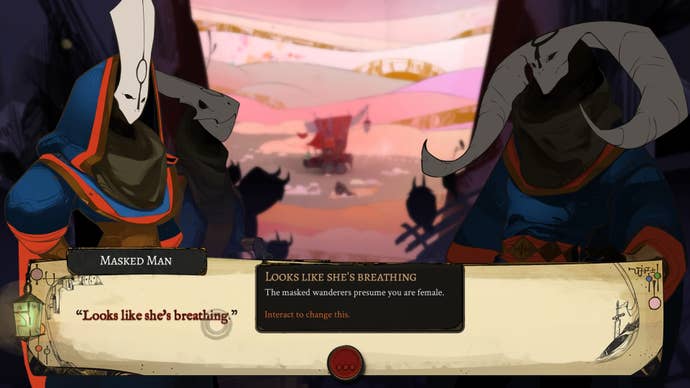
The Rites are easily the best part of Pyre. Matches are fast and always tense, with different maps and plentiful characters to switch from. In a round of Pyre, your team composition is everything. It's essential to pay attention to your enemy's team comp as well—exploiting their weakness will always give you an edge in the ensuing orb tossing. And luckily, the Rites don't only live in the game's lengthy campaign. There's a versus mode too, complete with all the game's characters (even those not in your party of the Nightwings), amounting to 21 overall. Unfortunately, the game is without online play, leaving it to local versus against a friend or AI only.
Aside from the odd sport, Pyre is rooted wholly in fantasy, unlike the games of Supergiant's past. It's where humans and tree people and worms and fox-like beings all live together in imperfect harmony. The world is lush with color and overbearing gloom; the creatures you meet all stick to their own friends in the unsavory place, clinging to the little hope they have left.
I only wish those hopes were front-and-center. Instead, characters fit their specific molds, and hardly grow beyond them. They're sidelined by another purpose, a nebulous "Plan" concocted by the wise Volfred. Volfred's insistence on the "Plan"—that is liberating every party member one by one through the Liberation Rite and hatching a plan of quiet, civil rebellion in Commonwealth—overshadows everything else in the game. The Plan becomes the sole focus, when all I really wanted to know was what these characters had to go back to, why they were banished in the first place, and why they opted to go along with this plan at all. Instead, that info is buried in character biographies and quick conversations that would pop up randomly in our communal wagon. And even those of substance were few and far in between.
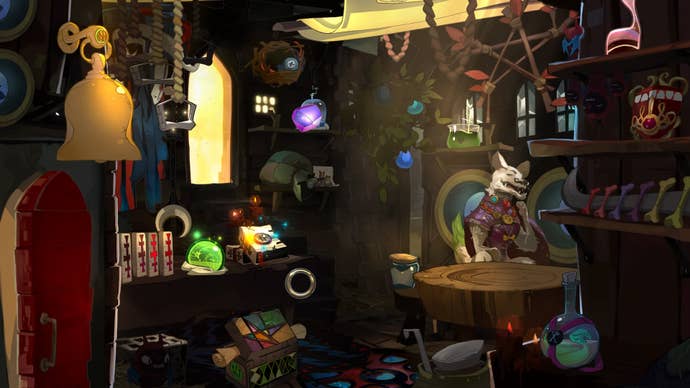

As I played through Pyre, I felt as if I wanted to like it more than I did. Its characters were wonderfully unique, but I never felt like I got to know them beyond the fleeting conversations we'd share in the confines of the wagon. When there was a rift between two characters, to the point where they wouldn't battle alongside each other (thus causing me minor annoyance), I wished for more scenarios like it. We all shared a common goal of attaining freedom and doing our darndest to rebel on the outside, but we hardly talked as to why, or even butt heads about it. As the game scaled upwards of a dozen hours, I was surprised at how little that time was spent getting to personally know my exiled companions.
Pyre's a complicated game, one that I loved in moments and felt bored stiff in others. It begins faltering when it hits its formulaic methods in the mid-to-late game: where you embark on three pyre battles, do a Liberation Rite, rinse repeat. In a stranger sense, it effectively works against what we expect in RPGs. Instead of growing stronger over time, you're growing weaker: you're slowly but surely casting off your exiled friends to "freedom," but losing them on a personal level in the process. Your win-state, instead of leveling up, is tethered to losing combatants at your side. Whereas in the twisted lose-state, you keep them alongside you, but as a result your eventual revolution up in Commonwealth grows more and more unlikely. The lose state may be better in the moment to moment, but in reality, it's amounting to a probable bad end.
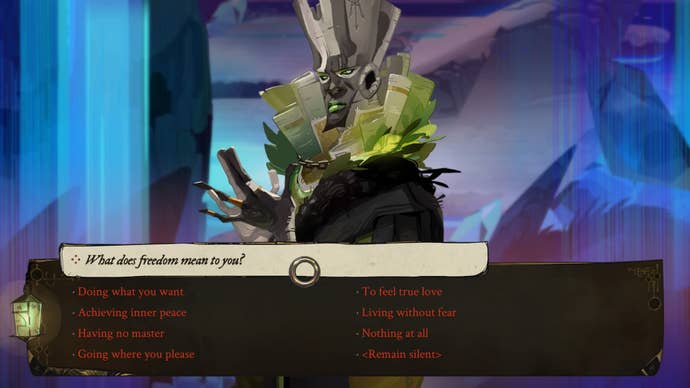
As much as I loved everything else about the game—its world, its structure, its art, its music, its battle system—it missed the mark where it positioned it to matter most: in its story, its characters, and their righteous goal. As a result, the game felt too expansive, at times even unfocused. When the game finds routine in a formulaic route for over half the game, it stumbles where it had time to flesh out its characters.
The lack of a game over poses a worthy twist on the RPG genre (but more akin to visual novels) at least: where every playthrough is catered to every choice you make. What would life be like if you took the path Jodariel suggested instead of Hedwyn? What would happen if none of your friends were successfully liberated? In Pyre, these types of choices—both little and small—are always yours, and sometimes, your skill on the rites-field depends on it.
This makes every playthrough unique. The initial story I saw in Pyre will be different from yours. Like how I lost that single Liberation Rite because I was reckless with igniting Titan constellations in the sky—which are handicaps that make a Rite harder but give you "enlightenment" (or, experience) bonuses, such as the enemy's pyre starting out with 30 more health. There was no game over screen, my team just dealt with the loss, was noticeably solemn for a time, before growing stronger from it. I, the Reader, just knew never to activate an unruly amount of Titans then on. In the end, I guess I learned my lesson too.
Lasting AppealThere's a lot of replayability here, whether just through its versus mode for local multiplayer, or in its choice-driven gameplay. Every player's path through Pyre will likely be different.
SoundSupergiant has been known to compile some of the best scores for their games in the past, and Pyre is no exception. Though it is notably more subdued, when the music swells, <em>it swells.</em>
VisualsPyre looks gorgeous at every turn, from its stagnant character art to the lush backgrounds in its campaign.
ConclusionPyre's strengths lie in a lot of things: its beautiful visuals, amazing score, multi-branching tale, gameplay that somehow marries the best of sports games and tactical RPGs. But it's wrapped in an expansive story that doesn't quite earn its keep over its many hours, and fails to flesh out the endearing characters you meet and spend time with all along the way. In the end though, Pyre's a quest worth taking if you're up for the challenge and the inevitable dread you'll feel when you lose sometimes.









